Spain's ingenious fairy-tale houses
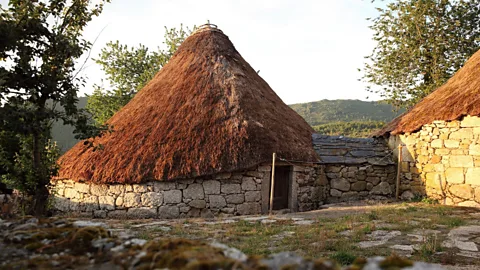 Itxaso Zuñiga Ruiz
Itxaso Zuñiga RuizThe round stone dwellings of Spain's Ancares Mountains may look like something out of the Asterix comics, but they're perfectly designed to withstand the region's harsh climate.
Deep in Spain's north-western corner, the windswept Ancares mountains are dotted with centuries-old houses that look straight out of a fairy tale – or the Asterix and Obelix comic-book series – but that are cleverly suited to the harsh realities of this remote region.
Known as pallozas, the round huts are made of stone and topped with a teardrop-shaped roof of rye straw. There are more than 200 scattered among Galicia's and Castile-León's rural villages, including Piornedo, Balouta, O Cebreiro and Balboa. Many of these homes were built 250 years ago, though their architectural roots stretch back millennia – some historians contend that pallozas are pre-Roman, an evolution of Celtic and Iron Age constructions.
 Itxaso Zuñiga Ruiz
Itxaso Zuñiga RuizPerfectly adapted to their environment
Pallozas are built from just a handful of materials: stone, wood and rye straw. However, despite their simplicity, they are perfectly adapted to the mountain region's cold, windy conditions. For example, their round shape – with few windows or openings – lessens the impact of harsh mountain winds. And thick stone walls – made with granite, limestone or slate, depending on which was available in the area – insulate from the cold and conserve interior heat. Inside, the palloza's fireplace and its indoor stable (for the family's cattle) are essential for maintaining a constant temperature.
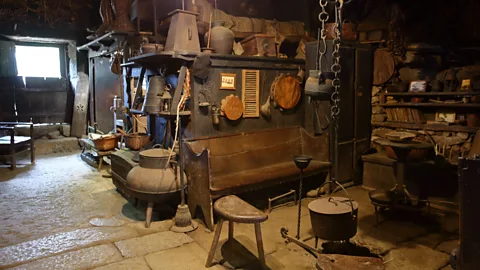 Itxaso Zuñiga Ruiz
Itxaso Zuñiga RuizWhere the best memories are born
Jaime Fernández Uria, a retired Barcelona civil servant, is now owner of the palloza he grew up in. It's one of the last four in Balouta village, in León province, and today he uses it only for storage.
Sitting next to the same fireplace that warmed four generations of his family, he explained how each palloza has two clearly distinguished areas inside: the ástrago, where people live; and the estravariza, the animal stable. He slept above the stable until he was 14, on a wooden platform warmed by the animals below it. "We used to have cows, pigs, chicken and a horse," he said nostalgically.
Traditionally, the lareira (fireplace) in the centre of the ástrago was where the family came together to chat, eat and carry out tasks like preparing food, weaving wool or repairing tools. Food such as chestnuts, cheeses and meat were kept above the fire, where the rising smoke protected it from rodents. Next to the fire there may have also been an oven and a small pen for young animals that needed more warmth. A private bedroom built with wooden planks could be found on the other side of the ástrago, and it was reserved for the oldest married couple living in the house. "My mother was the last one to live here, until 1984." said Fernández.
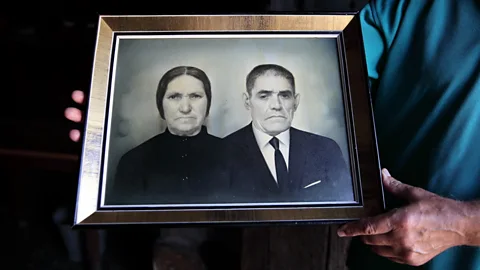 Itxaso Zuñiga Ruiz
Itxaso Zuñiga RuizA family's legacy
Fernández has fond memories of living with his parents and grandparents in their palloza. His family was humble, with only a few cattle and not much land, but they were very popular. Manuel "Moreno" Cadenas Barrero, a family friend, recalled the convivial ambience in their home.
"Their fireplace was always crowded with men sitting around it. Fernández's grandfather had a great sense of humour. He was a great comedian, the best at telling jokes and stories. Everyone was always welcome in this palloza," he told me, pointing at the lareira. "In this place, I have the best memories from the old times."
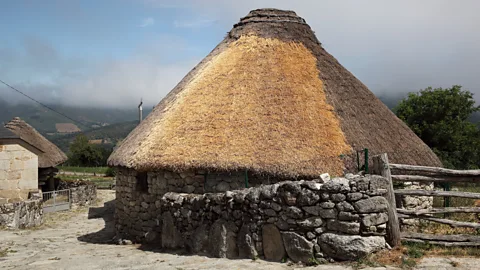 Itxaso Zuñiga Ruiz
Itxaso Zuñiga RuizThe palloza's main challenge
For centuries, rye was the predominant cereal cultivated in the Ancares mountain valley, but over the past few decades, as the region's population and rye crop have declined, palloza owners have struggled to keep the teito (roof) in good condition.
The teitador – the profession of building and repairing a teito – is slowly disappearing too. "Every year we spend from 2,000 to 3,000 euros to repair a patch, the most damaged part of the roof. We do it ourselves, harvesting our own straw, otherwise it will be much more expensive," said Isolina Rodríguez López, owner of the Casa do Sesto Palloza Museum in Piornedo village. She was the last of six generations to be born in this house, and she and her husband converted it into a museum in 1989.
The neighbouring palloza, where Celia Alonso López was born in 1959, needs a full teito repair. "It rains longer inside than outside," Alonso told me while looking at the roof's leaks one rainy afternoon. "It will cost me 50,000 to 60,000 euros to repair the entire teito. But without help from the regional government, I can't do it," she said. Some owners ended up installing a metal roof sheet; no one likes the solution, but it's a more affordable choice.
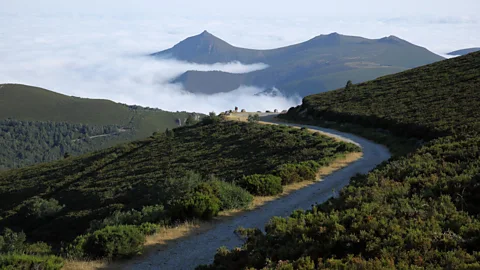 Itxaso Zuñiga Ruiz
Itxaso Zuñiga RuizAn isolated, unspoiled backdrop
For centuries, the palloza was the centre of a remote subsistence economy in which families produced everything they needed, with very little dependence on the outside world. Until the 1980s, the remote villages in this region didn't even have electricity, water or paved roads. Villagers travelled in carriages pulled by animals. "My parents used to go to Navia de Suarna village by horse following the mountain trail," Fernández said. Some things have modernised since then, but the poor condition of steep, winding, narrow roads and the spotty mobile network coverage are still good reminders of the Ancares' remoteness.
However, thanks to that unspoiled landscape, isolated location and complex biodiversity, the Ancares region was declared an Unesco Biosphere Reserve in 2006. The altitude here varies from 800m down in the valley to 1,670m in the Ancares , creating a climate that sees a lot of rainfall, winter snow and moderate temperatures in the summer, although that is changing, like elsewhere in the world.
"It is much hotter and snows much less than when I was a kid," said Moreno, who is now in his late 70s.
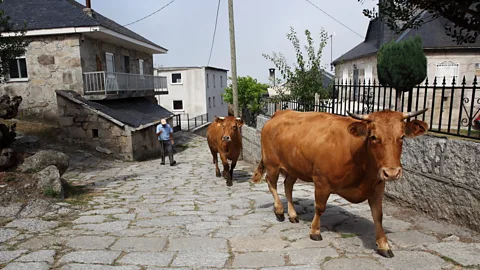 Itxaso Zuñiga Ruiz
Itxaso Zuñiga RuizRye, potatoes and chestnuts
Despite the tough climate and poor soil, residents traditionally raised cattle and pigs and grew vegetables such as potatoes, collard greens, onions and, in some areas, beans. The pig slaughter was celebrated as a festival.
Chestnuts were the most important harvested fruits, along with apples, and today there are still plenty of chestnut forests in the surrounding mountains.
Rye was the Ancares cereal par excellence, as it was the best adapted to the terrain and climate – and once every few weeks, families from different pallozas gathered at one stone oven to cook their loaves. "Baking and of course tasting that rye bread was awaited every month," said Alonso.
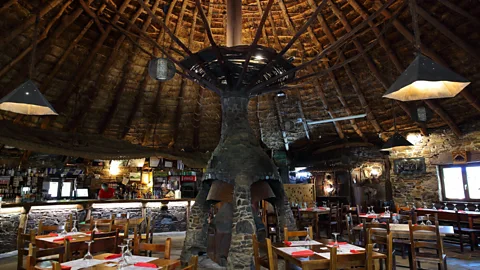 Itxaso Zuñiga Ruiz
Itxaso Zuñiga RuizChange with the times
As times change, the majority of residents – whose families have lived in their pallozas for three or four generations – have had to modernise. They've reconfigured and refurnished interiors, replaced the iconic roofs with cheaper and more accessible metal options, and in some cases converted their pallozas into tourism businesses, such as museums, hotels or restaurants.
For the past seven years, Miguel Angel Corullón Caurel and his wife Patricia Prieto Mauriz have been managers of La Palloza de Balboa restaurant in Balboa, which specialises in local and traditional gastronomy from the Leones Ancares region. Their building was constructed by the Balboa neighbourhood council using recycled materials from older pallozas in 1994; it was first used as a concert hall, but soon became a restaurant. "This is the most picturesque business we have ever had. We felt in love with the surroundings," said Prieto, sitting under the shade from an old birch tree.
When they took over the business, their first change was to make the palloza more energy efficient. Without the usual animal stable, living compartments and all-day fire, and with the addition of many new windows, they found it hard to keep the 280 sq m restaurant heated, especially when winter temperatures can drop to -10C. After the first year, they installed a heated floor, roof ventilators to bring the warm air back down, and LED lights to offset the energy usage. In a structure made with natural materials and surrounded by nature, maintaining the building and keeping pests away is another challenge.
"But it is worth the effort when you see the amazed faces from the kids entering such a unique restaurant," said Corullón. After all, whether modernised or not, it's hard not to feel like you've stepped into a fairy tale.
Heritage Architecture is a BBC Travel series that explores the world's most interesting and unusual buildings that define a place through aesthetic beauty and inventive ways of adapting to local environments.
---
more than three million BBC Travel fans by liking us on Facebook, or follow us on Twitter and Instagram.
If you liked this story, sign up for the weekly bbc.com features newsletter called "The Essential List". A handpicked selection of stories from BBC Future, Culture, Worklife and Travel, delivered to your inbox every Friday.
